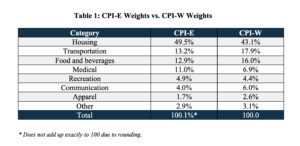By Daisy Brown, Legislative Liaison
A new bill proposed this Spring by Pennsylvania Senator Bob Casey could bring meaningful, positive change for Social Security benefits and seniors. Called the Boosting Benefits and COLAs for Seniors Act, it would direct the Social Security Administration (SSA) to adjust benefits based on an inflation index tailored to the budgets of elderly Americans rather than the current index, which is based on the budgets of urban wage earners.
More specifically, the bill would tie COLAs to the Consumer Price Index for the Elderly (CPI-E) rather than the Consumer Price Index for Urban Wage Earners (CPI-W), a change that TSCL has long advocated. It would also require the Bureau of Labor Statistics to begin calculating and publishing the CPI-E every month. Even though it might seem small on the surface, this change would be huge for seniors over the long term.
TSCL calculates that the CPI-E regularly puts spending inflation for seniors about 0.2 percentage points higher than the CPI-W. This adds up to about $45 more per year for 2024’s average Social Security check of $1,860, which isn’t much. But if you start projecting into the future, the power of compound interest kicks in. We estimate that a senior who filed for Social Security with average benefits over 30 years ago would have received an additional $14,000 in payments if COLAs had followed the CPI-E instead of the CPI-W. That’s the difference, for example, a senior might need to replace an aging vehicle with a modest used car.
If you’re curious why using the CPI-E for COLAs would work so much better for seniors than the CPI-W, it helps to understand how the CPI works.
The CPI is a tool to track inflation that’s a weighted average of inflation across different spending categories, and different versions of the index use different weights. As you can see in Table 1, the CPI-E puts extra emphasis on things like housing and healthcare that are especially important for older Americans.
As it stands, though, it’s hard to find CPI-E data. BLS doesn’t publish it as regularly as the CPI-W, which is where the second part of the Boosting Benefits and COLAs for Seniors Act would come in. The bill would require BLS to publish the CPI-E every month, which would make it far easier to understand how seniors’ costs are changing over time.


